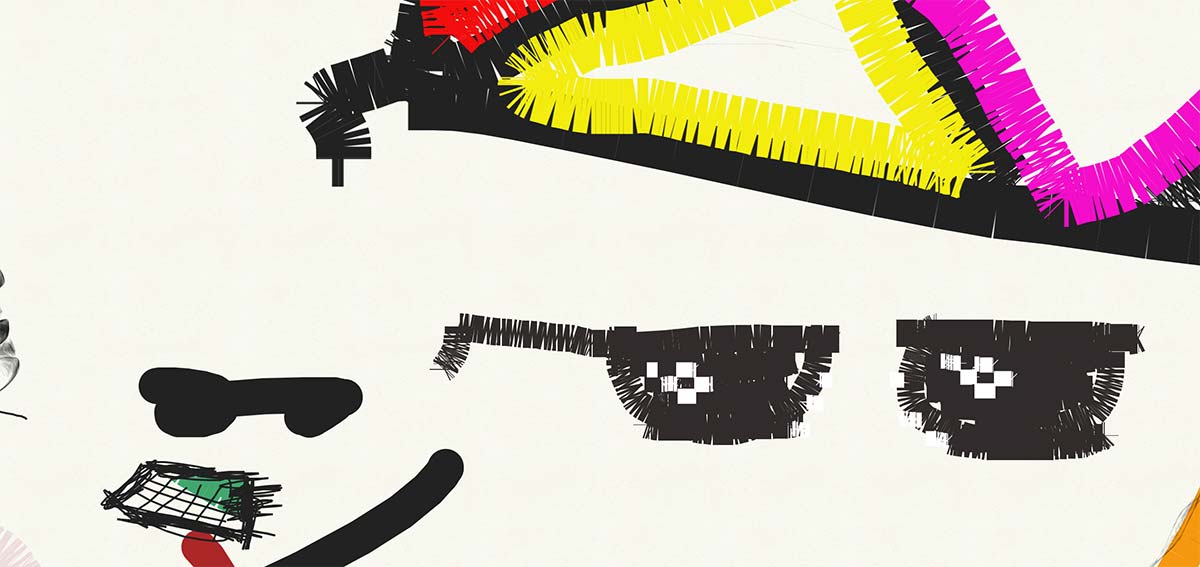udraw: Multiplayer Drawing Canvas

udraw is a multiplayer drawing application like many other drawing apps that have surfaced since the rise of WebSockets. Mine expands in size, allowing huge drawings on an unlimited-sized surface. Each canvas area is broken into 256x256 pixel tiles drawn on a single HTML5 canvas seamlessly to make drawing on a large canvas possible. Here it is embedded below. Alternatively, you can visit the full version at https://udraw.me
Panning around updates the URL to display your current location. Thanks to the browser history API, people can link to the same visible region.
The UI has the basics, such as a brush, pencil, and colour picker, along with the ability to move around with WASD key bindings and mobile touch gestures. When a draw stroke finishes, all the changed tiles are set dirty, and then the region is synced on the server side with an HTTP PUT request. To save bandwidth, I hope to implement partial updates of a tile region by sending a PATCH request ‘diff’ rather than sending the entire tile.
I was originally going to extend a JavaScript map library to add the drawing interface and save it on top. Most map libraries use the Spherical Mercator Projection, but I’m glad I didn’t for mathematical nightmare reasons. It would have been cool to use a Mercator projection to allow the drawings to be mapped onto a sphere in WebGL. Maybe another time!
Another possible area that needs exploring is the ability to store the diffs of the pixel data in some form of stack data structure on Redis. This would make undo rollback features possible. This might be quite easy in Redis with its already existing logging features. For example, keeping the last 20 update diffs of a given tile or having a TTL before flattening the image tile after a period of time.
A version hash could represent the latest state. ETags might be an ideal trick as these are sent when by the browser, even on PUT update requests. If the tag has changed (by another person updating first), maybe try merging the changes by getting the ‘newest’ changes applied on top of the current version in the client. It’s not likely this would work well; it's much like pushing code when your code branch is behind a few commits. This is where WebSockets come to the half-useful rescue by trying to simulate the remote drawing action when two people are drawing in the same area, hoping both clients interleave the latest image state from their screen. It doesn’t work well in many situations, and browser vendors render lines and shadows differently on different OSs.
The Back End
The back end is accessed with a simple RESTful interface for loading and saving tile regions. Real-time events such as mouse movement or tool changes are performed over WebSocket for browsers to simulate real-time aspects. After many roadblocks trying to use Java, I switched back to the NodeJS, Express, and Socket.IO combo.
I can spin up many NodeJS worker processes behind Nginx. A single Redis server stores all the tile data and relays the Socket.IO events to the other running NodeJS processes to keep everything in sync.
A note on HTTP/2
Annoyingly, NodeJS still does not support HTTP/2 out-of-the-box due to issues around SSL libraries and Express appearing to be dying based on GitHub activity. Multiplexing might reduce the latency for requesting multiple tile resources to the browser. Another cool feature HTTP/2 has is the ability to send Server Push messages, which could send down cache invalidations when another user updates a tile. I managed to clean the dust off the C compiler and started playing with nghttp2, which has a high-level Boost ASIO library, which has been quite painless to write the REST interface on. I haven’t seen any significant speed improvements with HTTP/2 multiplexing. Some even raise questions about its performance in high bandwidth usage applications and its potential to perform worse because of the extra overhead multiplexing streams over a single TCP pipe.
In my spare time, I will continue working on getting the bugs UI out and keeping a watch on web app development with HTTP/2. I certainly don’t think it’s something you can just install and expect 40% speed improvements without any effort to tune what assets need to be pushed and how priorities and streams are handled.
Image Processing
Another advantage of switching to C/C++ is a multitude of available native libraries for image processing such as using ImageMagick, making it smart with OpenCV or getting silly with procedural texture generation. One big request everyone wants is zoom! Pre-cached down-sampled images could be requested to see the entire canvas of drawings. I don’t think it would be easy to allow drawing on separate zoom levels as that might get quite expensive to keep all the levels up to date, not to mention the loss when drawing while zoomed out.
Another issue is removing dick pic drawings. That might be a fun and challenging area to explore with OpenCV. Being able to build a model derived from known dick pic drawings or use some form of cutting-edge artificial neural networks to clean away rude drawings. I’ll call it APDRA (Adaptive Penis Detection and Removal Algorithm). Perhaps Google will already have plenty of research for this!
